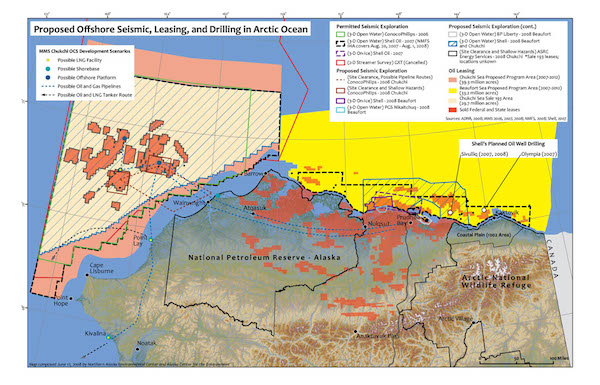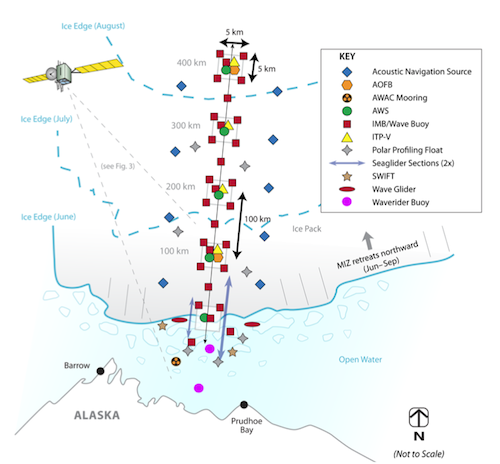Oil industry noise headed for arctic waters
Effects of Noise on Wildlife, News, Ocean, Ocean energy, Seismic Surveys Add commentsShell Oil is gearing up to do the first new exploratory drilling in the Chukchi Sea off northwestern Alaska. The project has been in the pipeline for years, and has faced numerous legal challenges (mostly regarding the danger of a spill and climate imperatives) and logistical snafus (the most extreme being a drill ship that ran aground). Just last month, a consortium of environmental groups filed a suit challenging the most recent permits; there has yet to be a ruling. The expansion of oil and gas development from Alaska’s north slope to offshore waters will create a marked increase in human noise in an ocean region that is currently relatively free of our intrusions. Exploration leases have been sold in both the Chukchi Sea (left below) and Beaufort Sea (right below).
Earlier this year, the Obama administration officially put some areas in these waters off limits, but a close inspection of the maps presented then reveal that virtually none of these areas were planned for development when the above map was created in 2008; the exclusion zones appear to match the near-shore areas excluded above (one exception: a small portion of the Chukchi zone is now off-limits).
Noise concerns extend far beyond the drilling itself, or even the seismic surveys that take place prior to drilling and during the life of the project. The drill rigs come along with a support fleet of 30 other boats and several aircraft, promising a steady din in the area. “In the Arctic, I can’t emphasize how novel an activity this is,” says NRDC attorney Giulia Good Stefani. “It really is a whole new level of disturbance for an area already experiencing rapid change and stress.” Concerns extend from whales to walruses, seals, and polar bears.
A wide array of ongoing research is underway, aiming to characterize the current soundscape in arctic waters. An extensive collaboration is using a variety of recording approaches to gather baseline sound data from Alaska to Greenland, and across the polar seas (see this project summary: Multipurpose Acoustic Networks in the Integrated Arctic Ocean Observing System). One recent study that’s part of this effort used moored hydrophones, buoys, and gliders to assess sounds from shore to the edge of the ice pack as it retreated:
Gliders are also being used on their own in a number of studies, including one that’s getting underway this week in the Chukchi. It’s worth stressing that the waters of the arctic are far from quiet; noise levels tend to track wind speed (waves being the dominant natural noise source), and shifting ice creates bursts of extremely loud sounds. Still, acoustic monitoring has also heard seismic surveys from hundreds of miles away, and a recent acoustic study in the Beaufort Sea suggest that bowhead whales changed their vocal patterns when exposed to much lower levels of human-made sound than previously considered likely to cause any problems. The whales increased their call rates as soon as airguns were perceptible, began reducing their calls at only 128dB and by the the time sound levels reached the typical behavioral effects regulatory threshold of 160dB, the whales were “virtually silent.” As Michael Stocker of Ocean Noise Research notes, “By the time the mitigation threshold kicks in the bowheads have already tossed in the towel. It seems that we will need to completely reframe our mitigation practices and admit we’ve been lousy ocean neighbors, or bluntly stomp away regardless of behavioral impacts.”


